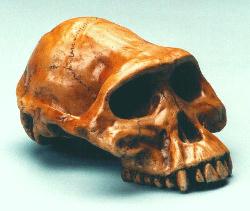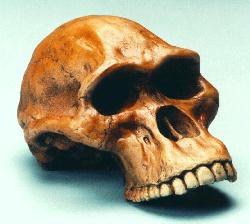 the hominid record has too few specimens which are too temporally and geographically
separated to fill in the complete picture of the course of hominid evolution.
the hominid record has too few specimens which are too temporally and geographically
separated to fill in the complete picture of the course of hominid evolution.
Modern humans
are thought to have evolved through many in between steps from ape-like
ancestors. As with most groups, the hominid record has too few specimens which are too temporally and geographically
separated to fill in the complete picture of the course of hominid evolution.
the hominid record has too few specimens which are too temporally and geographically
separated to fill in the complete picture of the course of hominid evolution.
Paleoanthropologists have different
ideas about the actual number of distinct evolving hominid lineages which
have existed throughout time. These authorities also differ on their opinions
of the interrelationships amongst the different hominids.
For example, previous work had always
placed Australopithecus afarensis at the base of the family tree
and believed that the genus of Homo arose directly from this species.
It is now believed, however, that our genus, Homo, may have arisen from
the species Australopithecus africanus. Australopithecus africanus
shares
more features with
Homo habilis, the first member of the genus Homo,
than does afarensis. Africanus has a larger brain, shorter
face and smaller canine teeth. From the neck down, however, africanus
more closely resembles an ape.

One possible answer for the ape-like
limb proportions of A.africanus is that the area in which this species
lived may have been forested for a longer period of time than the area
in which A.afarensis lived. This would require the species
to maintain the ability to climb trees and therefore retain its longer
arms and shorter legs. Perhaps the reason why A. africanus
developed a larger brain can be attributed to the environment from in which
it lived.